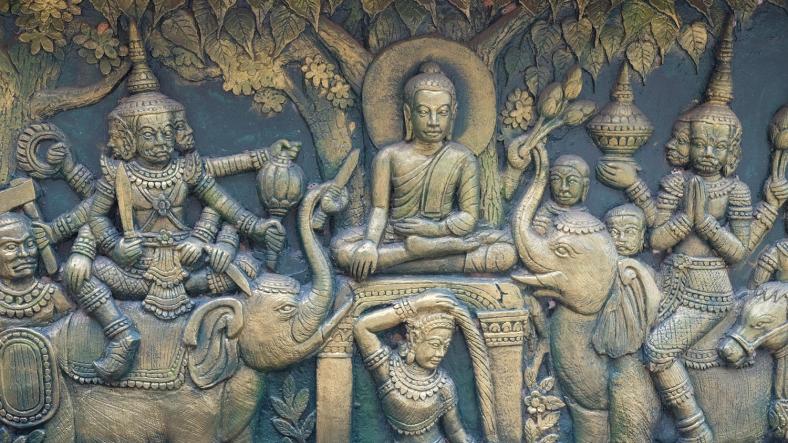Yoga, a spiritual and physical discipline, has deep roots in the ancient Vedic texts of Hinduism. Originating in the early Vedic period, yoga has evolved significantly over millennia, intertwining with various philosophical and religious traditions.
This article explores the connection between the Vedas and the development of yoga, tracing its origins, evolution and enduring significance.
Origins of Yoga in the Vedic Texts
1. Vedic Roots and Early Practices
- Vedic Context:
- The term yoga is derived from the Sanskrit root yuj, meaning "to yoke" or "to unite."
- In the Vedic context, it primarily refers to the discipline of spiritual practice aimed at uniting the individual self with the divine or cosmic order.
- Vedic Hymns and Rituals:
- The Vedas, especially the Rigveda and Yajurveda, contain references to ascetic practices and meditative techniques.
- Although they do not explicitly describe yoga as it is understood today, they lay the groundwork for its development.
2. Meditative and Ascetic Practices
- Ascetic Traditions:
- The Vedic texts highlight the importance of ascetic practices (tapas) and meditation (dhyana) as means of spiritual purification and divine communion.
- These practices are precursors to the more systematic approaches of yoga found in later texts.
- Ritual and Sacrifice: The emphasis on ritualistic purity and self-discipline in the Vedic sacrifices parallels the principles of control and focus seen in yoga.
Transition from Vedic to Post-Vedic Yoga
1. Upanishadic Yoga
- Philosophical Foundations:
- The Upanishads, which build upon Vedic ideas, introduce more explicit concepts related to meditation and self-realization.
- They explore the nature of the self (Atman) and its unity with the ultimate reality (Brahman), which are central themes in yoga.
- Meditative Practices:
- The Upanishads describe meditative techniques and practices aimed at achieving spiritual enlightenment and inner peace.
- These practices mark the transition from ritualistic to contemplative yoga.
2. The Bhagavad Gita and Yoga
- Integration of Yoga:
- The Bhagavad Gita, a key text of Hindu philosophy, integrates various forms of yoga, including karma yoga (the yoga of action), bhakti yoga (the yoga of devotion) and jnana yoga (the yoga of knowledge).
- It provides a comprehensive guide to the practice of yoga within the context of duty and righteousness.
- Theological and Philosophical Insights: The Gita emphasizes the importance of self-discipline, devotion and knowledge, aligning with the goals of yoga as a path to spiritual realization.
The Systematization of Yoga
1. The Yoga Sutras of Patanjali
- Codification:
- Patanjali's Yoga Sutras (circa 200 CE) represent a significant development in the systematization of yoga.
- Patanjali outlines the eight limbs of yoga (ashtanga yoga), which include ethical guidelines, physical postures, breath control and meditation.
- Philosophical Framework:
- The Yoga Sutras provide a structured approach to achieving samadhi (spiritual absorption) and liberation (moksha).
- This text marks the transition from Vedic and Upanishadic practices to classical yoga.
2. Hatha Yoga and Tantric Influences
- Physical Practices:
- Hatha yoga, which emerged around the 11th century CE, focuses on physical postures (asanas), breath control (pranayama) and bodily purification.
- It incorporates elements from tantric traditions and emphasizes the transformation of physical and subtle energies.
- Integration with Tantra: Hatha yoga integrates practices from Tantric rituals and philosophy, aiming to awaken spiritual energy and achieve union with the divine.
Modern Interpretations and Global Influence
1. Modern Yoga Movements
- Yoga Renaissance:
- In the late 19th and early 20th centuries, yoga underwent a renaissance, with figures like Swami Vivekananda and B.K.S.
- Iyengar popularizing yoga in the West. Modern yoga incorporates diverse styles, from classical and traditional to contemporary and therapeutic.
- Globalization:
- Yoga has become a global phenomenon, with millions of practitioners worldwide.
- Modern yoga continues to evolve, blending traditional practices with contemporary wellness and fitness trends.
2. Contemporary Relevance
- Holistic Health:
- Modern yoga emphasizes physical health, mental well-being and spiritual growth.
- It is widely practiced for its benefits in stress reduction, flexibility and overall health.
- Cultural Exchange: The global spread of yoga has facilitated cross-cultural exchange and increased awareness of its Vedic origins and philosophical underpinnings.
Conclusion
The Vedas laid the foundational principles for yoga, with early practices focused on asceticism, meditation and ritual discipline. Over time, yoga evolved through the Upanishads, the Bhagavad Gita and classical texts like the Yoga Sutras, incorporating philosophical insights and systematizing practices. Today, yoga continues to thrive as a global practice, blending traditional wisdom with modern approaches to health and spirituality.
The enduring influence of the Vedas on yoga underscores the deep connections between ancient texts and contemporary practices, highlighting the timeless relevance of these sacred teachings in the quest for spiritual and physical well-being.















